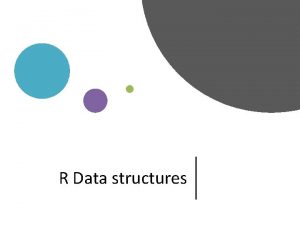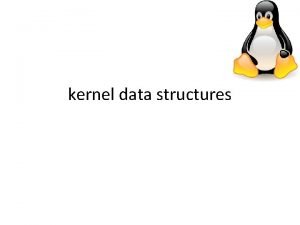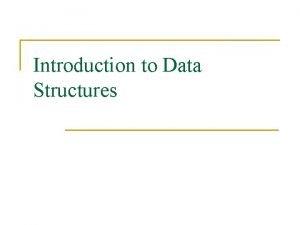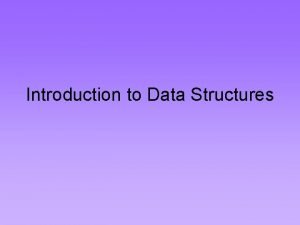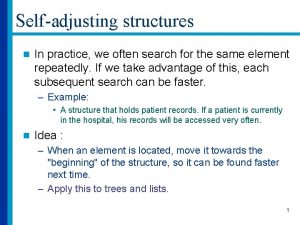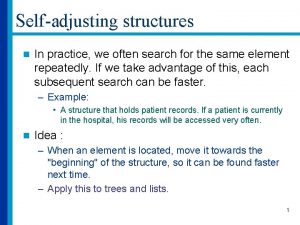SelfAdjusting Data Structures 1 movetofront SelfAdjusting Data Structures







- Slides: 7

Self-Adjusting Data Structures 1

move-to-front Self-Adjusting Data Structures 2 7 4 1 9 5 3 Search(2), Search(2) , Search(5), Search(5) 5 2 7 4 1 9 3 Lists [D. D. Sleator, R. E. Tarjan, Amortized Efficiency of List Update Rules, Proc. 16 th Annual ACM Symposium on Theory of Computing, 488 -492, 1984] Dictionaries [D. D. Sleator, R. E. Tarjan, Self-Adjusting Binary Search Trees, Journal of the ACM, 32(3): 652 -686, 1985] splay trees Priority Queues [C. A. Crane, Linear lists and priority queues as balanced binary trees, Ph. D thesis, Stanford University, 1972] [D. E. Knuth. Searching and Sorting, volume 3 of The Art of Computer Programming, Addison-Wesley, 1973] leftist heaps [D. D. Sleator, R. E. Tarjan, Self-Adjusting Heaps, SIAM Journal of Computing, 15(1): 52 -69, 1986] skew heaps [C. Okasaki, Alternatives to Two Classic Data Structures, Symposium on Computer Science Education, 162 -165, 2005] maxiphobic heaps [A. Gambin, A. Malinowski. Randomized Meldable Priority Queues, Proc. 25 th Conference on Current Trends in Theory and Practice of Informatics: Theory and Practice of Informatics, 344 -349, 1998] randomized version of maxiphobic heaps Okasaki: maxiphobic heaps are an alternative to leftist heaps. . . but without the “magic” 2

3 Heaps (via Binary Heap-Ordered Trees) 2 2 2 5 3 1 1 7 9 4 6 Make. Heap, Find. Min, Insert, Meld, Delete. Min 1 11 10 1 13 13 2 Meld ( , x y T 3 T 1 T 2 x<y ) Meld ( Ti largest size 13 ) = 2 2 Time O(log n) 2 4 7 9 1 4 1 7 2 9 1 13 1 [C. Okasaki, Alternatives to Two Classic Data Structures, Symposium on Computer Science Education, 162 -165, 2005] x = 1 , 3 2 ths t pa Maxiphobic Heaps 4 2 4 3 mos Each node distance to empty leaf Inv. Distance right child left child rightmost path log n+1 nodes Meld ( ight ge r 1 mer 2 Cut root + Meld [C. A. Crane, Linear lists and priority queues as balanced binary trees, Ph. D thesis, Stanford University, 1972] 3 [D. E. Knuth. Searching and Sorting, volume 3 of 2 The Art of Computer Programming, 3 Addison-Wesley, 1973] 2 8 12 Meld Leftist Heaps 2 1 = 1 , Tj ) Tk two smallest Max size n ⅔n Time O(log 3/2 n) 3

Skew Heaps [D. D. Sleator, R. E. Tarjan, Self-Adjusting Heaps, SIAM Journal of Computing, 15(1): 52 -69, 1986] Meld = = § Heap ordered binary tree with no balance information § Make. Heap, Find. Min, Insert, Meld, Delete. Min Cut root + Meld 2 5 7 12 3 9 4 6 8 10 § Meld = merge rightmost paths + swap all siblings on merge path 4 7 7 9 ths 9 a ost p 13 ) = 2 m ight , 4 ge r Meld ( mer 2 v heavy if |Tv| > |Tp(v)|/2, otherwise light any path log n light nodes Potential = # heavy right children in tree 13 O(log n) amortized Meld Heavy right child on merge path before meld replaced by light child 1 potential released for heavy child amortized cost 2∙ # light children on rightmost paths before meld 4

Skew Heaps – O(1) time Meld [D. D. Sleator, R. E. Tarjan, Self-Adjusting Heaps, SIAM Journal of Computing, 15(1): 52 -69, 1986] § Meld = Bottom-up merge of rightmost paths + swap all siblings on merge path not , 4 9 13 5 8 ths t pa 9 11 4 inor ly m 7 2 ious prev 7 3 6 mos or min 11 4 ight r 6 = ge r majo 8 2 3 2 mer 13 5 ) = 1 hed Meld ( 1 touc 1 = # heavy right children in tree + 2 ∙ # light children on minor & major path O(1) amortized Meld Heavy right child on merge path before meld replaced by light child 1 potential released Light nodes disappear from major paths (but might heavy) 1 potential released 4 and 5 become a heavy or light right children on major path potential increase by 4 O(log n) amortized Delete. Min Cutting root 2 new minor paths, i. e. 2∙log n new light children on minor & major paths 5

Splay Trees [D. D. Sleator, R. E. Tarjan, Self-Adjusting Binary Search Trees, Journal of the ACM, 32(3): 652 -686, 1985] § Binary search tree with no balance information § splay(x) = rotate x to root (zig/zag, zig-zig/zag-zag, zig-zag/zag-zig) root y x A zig C A x y A z C C zig-zag z y D x B x y y A B zig-zig z x D x B y A B C D B A C z B C D § Search (splay), Insert (splay predecessor+new root), Delete (splay+cut root+join), Join (splay max, link), Split (splay+unlink) v u F z zag-zag zig-zig x insert y E y C x B A C D B D E z F A D C B u v y v z A x u E F 6

Splay Trees [D. D. Sleator, R. E. Tarjan, Self-Adjusting Binary Search Trees, Journal of the ACM, 32(3): 652 -686, 1985] § The access bounds of splay trees are amortized (1) O(log n) (2) Static optimal (3) Static finger optimal (4) Working set optimal (proof requires dynamic change of weight) § Static optimality: = v log |Tv| 7


